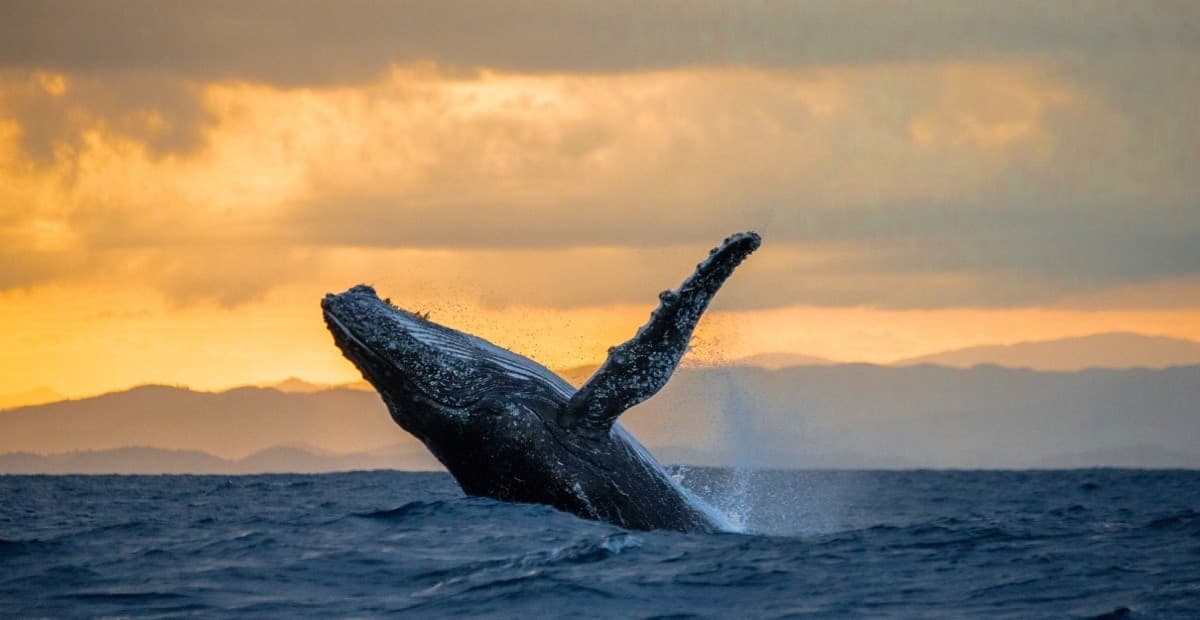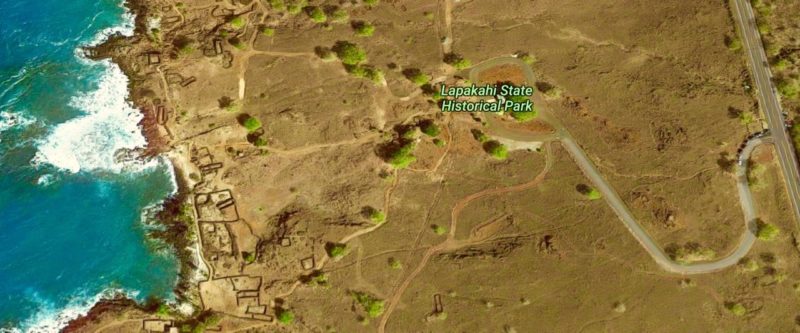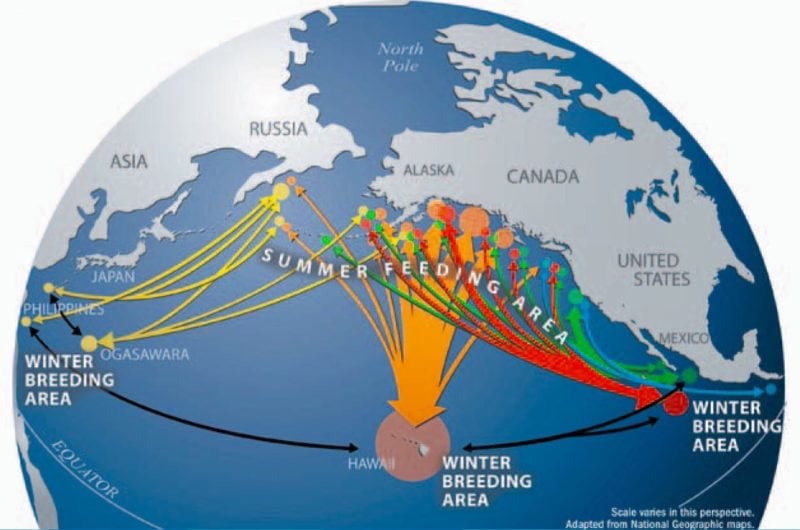Humpback whales make their annual journey to Hawaii between the months of November and April (whale season), and the Big Island is our favorite of the Hawaiian islands to see them.
Table of contents
- Whale Watching FAQ
- The 2024 – 2025 Whale Watching season has started
- Boat Tours
- DIY whale watching from the shore, including best viewing locations
- Our 7 best whale watching tips
- About Humpback Whales (why we such big fans!)
- And why do the whales come to Hawaii?
Table of Contents
- Whale Watching FAQ
- The 2024 – 2025 Whale Watching season has started
- Boat Tours
- DIY whale watching from the shore, including best viewing locations
- Our 7 best whale watching tips
- About Humpback Whales (why we such big fans!)
- And why do the whales come to Hawaii?
A quick summary: there are many ways to experience these majestic animals. You can listen to the whales under water, spot them from shore, or see them up-close from a boat.
Whale watching FAQ
Below we list the answers to questions that we are often asked. Please get in touch with us if you have a whale watching question that we have not yet answered.
You can see most whales off the north-western coast of the Big Island. If you want to watch them from the shore we recommend these 3 viewing locations. For whale watching tours those departing from Kona are preferable.
The most important distinction between whale watching tours is the size of the vessel. Small boats give a more personal experience and offer more flexibility but often lack in amenities. Because of this, whale watching tours from larger vessels (such as this one) have our preference.
The closest whale watching tours to the Kohala resorts depart from Kawaihae harbor. Have a look at this sunset whale watching cruise that offers free pickup from the Kohala resorts for a good option.
The first whales start arriving to the Big Island late November and more arrive as the season progresses, until their numbers peak in the months of January and February (source). The whales depart Hawaii again late April / early May. This means that January and February are the best months to see whales
Even though whales are active all day long we have a slight preference for whale tours that take place early in the day because that is when the ocean is most calm. A calm ocean makes it easier to spot whales.
While we have a strong preference for everything Big Island, we must give well-deserved credit to Maui as the best island for whale watching tours. This is because more than half of all local whales prefer the calm and shallow waters in the ʻAuʻau channel (located between Lānaʻi , Maui, Molokaʻi, and Kahoʻolawe).
2024- 2025 Whale Watching season has started!
Whale season started early this season, with a sighting on October 8 off the coast of Kāʻanapali (Maui).
Having left for a 3000 mile journey several months ago from Alaska, the first humpback whales have now arrived in the Hawaiian waters for a well-deserved winter-break!
Whale watching tours
Jump to:
- Tours on larger (pontoon or catamaran) style boats
- Tours on medium-sized vessels
- Tours on smaller (speed) boats
One of the easiest and most spectacular ways to see the whales is to join a boat tour. Tours are a fascinating experience and allow you to see the humpbacks from very close-by. They typically last between 2 hours and half a day, and cost between $100 and $150 per person. Next to seeing the whales, you might also see dolphins, turtles, or maybe even whale sharks!
There are many companies that offer whale watching tours on private boats, almost all along the Kona coast. Whale tours are only offered during whale season, starting typically early to mid December and lasting to the end of March.
The most important difference between these tours is their location and the size and type of boat, which ranges from cabin cruisers with multiple decks, to sailing catamarans, to pontoon type boats, to inflatable raft type boats (with and without rigid hulls or bottoms).
Location wise, most tours run along the Kona and Kohala coast, which is where most of the whales hang out. There are also few tours that leave from Hilo harbor (see below), which is convenient for people that stay on that side of the island.
Tours on larger (pontoon-style or catamaran) boats
- Larger boats have more amenities such as toilets and a bar on board
- Larger boat often have better equipment such as hydrophones (to listen to the whales) and a whale cam on board.
- Larger boats often provide more shade. For those people that want to get (or stay) get out of the direct sun if they want, larger boats often are a good choice.
- Pontoon type boats and stable catamarans like the one used by Body Glove (See the tour below) are more stable, which makes seasickness less of an issue.
A household name that we trust to provide consistently high-quality whale watching tours with a bar on board and great professional guides is Body Glove:
Whale Watching Cruise from Kona
2.5 hour Whale Watching Excursion with free snacks, guaranteed whale sightings (or come again!), an on-board marine life naturalist, and underwater hydrophones so you can hear the whales sing.
from:
$125
What is a suggested tour?Our suggested tours are hand-picked tours that receive consistent good reviews, give back to the community, and work hard to minimize their impact on the environment. Read more about these tours on our website.Tours on Medium-sized boats
Medium sized boats strike a middle ground between the comfort and capacity of the larger boats, and the speed and maneuverability of the smaller ones.
The following small-group tour takes place on a 46′ Newton dive boat, big enough to provide comfortable seating and amenities such as a private bathroom and a smooth ride for all ages, but still small enough tours to feel intimate with 24 people max. It also is one of the few whale watching cruises that takes place during the sunset hour, which gives you GREAT views of the Kona and Kohala coast during the golden hour and unique photo opportunities.
Sunset Whale Watching Cruise off the Kohala Coast 🌅
Combine a sunset cruise with whale watching and go in search of visiting humpback whales and resident spinner dolphins.
from:
$145
What is a suggested tour?Our suggested tours are hand-picked tours that receive consistent good reviews, give back to the community, and work hard to minimize their impact on the environment. Read more about these tours on our website.Tours on (often the fastest) small boats
- Smaller boats usually mean a faster bumpier ride, an increased chance of getting wet, and a more windy experience. Don’t choose a smaller boat if anyone in your group has neck or back issues.
- You are closer to the water level on smaller boats and therefore at the same level as the whales, which many people prefer.
- Faster boats can cover more whale watching sites which increases your chances for more whale sightings.
- Greater maneuverability: Speedboats are more agile and can change direction quickly. This allows for better maneuverability when trying to follow or approach whales, ensuring a more dynamic and interactive experience for the observers.
- Reduced Amenities: Speedboats often have fewer amenities compared to larger vessels. This may include less seating, limited shelter from the elements, and fewer onboard facilities, which could affect the overall comfort of passengers.
- Limited Observation Space: The smaller size of speedboats may provide limited deck space for passengers to move around and observe whales comfortably. This could be a drawback for those who prefer more spacious viewing areas.
A good example of a whale watching tour on a speedboat is the following tour on a 41′ super raft. Despite its limited size, it offers comfortable seating, shade, and even an on-board bathroom.
Super-Raft Speedboat Whale Watch
Enjoy the thrill of a sea raft ride with none of the drawbacks. Other than most rafts, our vessel is equipped with comfortable seating, shade, and a bathroom!
from:
$125
What is a suggested tour?Our suggested tours are hand-picked tours that receive consistent good reviews, give back to the community, and work hard to minimize their impact on the environment. Read more about these tours on our website.Make sure to bring your camera and to keep a tight grip on it when taking photos. Read our 6 great whale watching tips to prepare yourself for seeing the whales as well as possible. The following video shows humpback whales playing in the waters of Oahu’s North Shore:
Whale Watching Tours from Maui, Oʻahu, Kauaʻi, and Hilo
The warm and shallow waters surrounding the Hawaiian Islands are a favorite destination for humpback whales. Scientists estimate that a whopping two-thirds of the entire (!) North Pacific humpback whale population return to Hawaiʻi to breed, calve and nurse their young.
This means that you can also go whale watching from other islands:
Oʻahu whale watching tours
Most whale sightings on Oʻahu take place along the eastern point of the island and all along the northern and western shores. During whale season the hike out to the Makapuʻu lighthouse offers great opportunities for DIY whale watching.
If you are looking for a whale watching boat tour or cruise, you have many options of operators that depart from various ports along Oʻahu’s southern and western (leeward) harbors. Have a look at our guide to whale watching on Oʻahu for our recommendations.
Waikiki Whale Watch with a Sailing Catamaran
See humpback whales during their annual migration in the waters off Oʻahu from a catamaran on a whale-watching cruise from Waikiki. Enjoy great photo ops of these massive mammals as well as panoramic views of Honolulu and Diamond Head
from:
$99
What is a suggested tour?Our suggested tours are hand-picked tours that receive consistent good reviews, give back to the community, and work hard to minimize their impact on the environment. Read more about these tours on our website.Maui whale watching tours
On Maui, Lahaina Harbor is one of the most popular areas for whale watching tours, with most whales finding a temporary home in the Maui Nui Basin, as more than half of the local humpback whale population migrates there for breeding.
There are many types of whale watching tours available on Maui, from big boats like the Pacific Whale Foundation to small-group experiences on pontoon boats, such as the adventure offered by Captain Steve’s Rafting. Check out our Maui whale watching guide for more tips, tricks and recommendations.
Saltwater Sail With the Whales on Maui
Maui is the place to see humpback whales! Set sail in the Hawaiian tradewinds and join the Captain and Crew in keeping a look out for humpback whales
from:
$85
What is a suggested tour?Our suggested tours are hand-picked tours that receive consistent good reviews, give back to the community, and work hard to minimize their impact on the environment. Read more about these tours on our website.Kauaʻi whale watching tours
Kauaʻi is famous for its breathtaking Napali Coast coastline, and whale watching tours are a very convenient “two birds with one stone” style solution to get two tours for the price of one.
Of course, you can always keep an eye out for whales from land if you are visiting between December and May. Poʻipū Beach, Kīlauea Lighthouse, Kealia Beach, and Kapaʻa, are all good places to do so. However, we strongly recommend you join a whale watching cruise. Many sailing and snorkeling cruises that explore the Napali coast year-round adjust their focus during whale season to maximize the chances to see whales.
Curious? Read more in our guide to Kauaʻi whale watching.
Whale watching tours from Hilo (Big Island)
While most whale sightings happen along the western coast of the Big Island, you can see plenty of whale-action on the east side of the Big Island at Hilo Bay – another place popular to see humpback whales. Tours leaving from Hilo have the added benefit of the beautiful backdrop of the lush and tropical Hamakua coast.
Check out the Malama Charters website if you are looking for whale watching tours from Hilo.
How to see Humpback whales from the shore
You can easily see humpback whales from the shore of the Big Island during the winter months. The three ingredients you need for shoreline whale spotting are:
- A good place where you can relax for a while and keep your eyes on the ocean.
- Some luck.
- Patience.
Good to know: you can combine trying to see whales from the shore with volunteering. Read more about the Sanctuary Ocean Count
The thing that will most often alert you to the presence of whales is a big spout of water from the ocean surface. This spout comes from a whale breathing out and in again and is visible from relatively large distances. Keep your eyes on/near this spot and you are likely to see more whale action.
In general, the best places to see whales from the shore are along the North Kona, Kohala, North Kohala, and Hilo coasts. More specifically 3 very good places to see whales from the shore on the Big Island are: Puukohola Heiau National Historic Site, Lapakahi State Historical Park and Kapa’a Beach Park.
We marked these spots on the following map below, scroll down to read more about them.
Puʻukohola Heiau National Historic Site
Puʻukohola literally means “hill of the whale” in Hawaiian, which should tell you a thing or two about why we’ve chosen this spot for our list. This is an excellent site for spotting whales and also offers sweeping and elevated views toward the Kawaihae Harbor.
The Puʻukohola Heiau site is an interesting place to visit on its own right. It also is located right next to the Spencer Beach park, where there are plenty of picnic tables, showers and a campground.

Spencer beach park offers good whale watching conditions through the tables next to the seaside. Image credit: Google street view.
Lapakahi State Historical Park
This park is located on the northeastern tip of the Big Island and is especially suitable for whale watching because of its 100 ft. elevation. You can find the Lapakahi State Historical Park along Highway 270 north of Kawaihae at mile marker 14. The viewing site is located ~100 yards (90 meters) past the gate and at the top of the hill. It is about a half a mile from the shoreline.
Kapaʻa Beach Park
Kapaʻa Beach Park is very close to Lapakahi Park and the best spot for whale watching is about 20 feet lower. However, it has one big advantage to make up for the slightly lower elevation: covered picnic pavilions!
Follow Highway 270 north and turn left on the one-lane paved road just past mile marker 16 to get to Kapaʻa Beach Park. The viewing site is located at the end of the road.
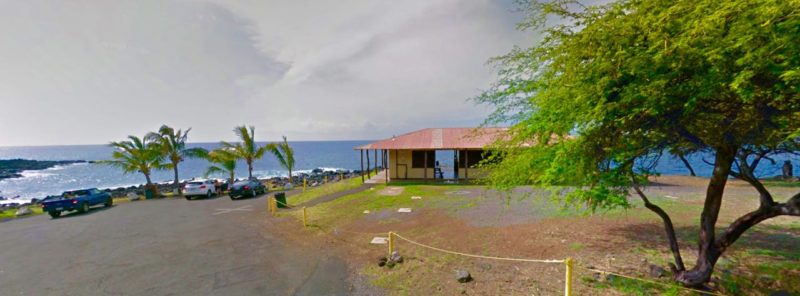
Ocean view and the covered picnic pavilion at the Kapaʻa beach park. Image credit: google street view.
Have a look at our humpback whale 101 for an identification chart of all possible humpback whale acrobatics such as the breach, the tail slap, the fluke up dive or the head lunge.
Whale watching as volunteer
Did you know that you can combine half a day of whale watching with volunteering if your timing is just right?
The Sanctuary Ocean Count project is a humpback whale monitoring project for residents and visitors alike. The purpose of the project is to have a yearly shore-based count during the peak breeding season, as humpback whales are counted from many locations on the shores of Oʻahu, Hawaiʻi and Kauaʻi.
The count is held 3 times a year: on the last Saturday of January, February, and March of each year from 8:00 a.m. to 12:15 p.m. You’ll need to register ahead of time to participate and can find more information at the Sanctuary ocean count website.
2025 Sanctuary Ocean Count dates
The 2025 Ocean Counts are scheduled for the following Saturday’s:
- January 25,
- February 22, and
- March 29.
Note: registration closes 1 week prior to the count dates, so make sure to plan ahead.
Whale Watching Tips
Seeing some of the largest animals on earth in their natural habitat is a fantastic experience. And of course, the more whales the better! We are here to help you with that.
Read our whale watching tips to be well-prepared for your trip and to help you be more successful at spotting whales:
- Look for whales during humpback whale season
- 4 great tips learned from 20+ years of whale watching and tens of thousands of whale sightings
- Where do most whales hang out?
- How to hear a humpback whale sing (with audio)
Whale Watching Cruise from Kona
2.5 hour Whale Watching Excursion with free snacks, guaranteed whale sightings (or come again!), an on-board marine life naturalist, and underwater hydrophones so you can hear the whales sing.
from:
$125
What is a suggested tour?Our suggested tours are hand-picked tours that receive consistent good reviews, give back to the community, and work hard to minimize their impact on the environment. Read more about these tours on our website.#1: When is Whale Watching season in Hawaii?
Humpback whale season on the Hawaiian islands is between November and Early May, but some months are better than others.
The first whales start arriving to the Big Island in late November, and more arrive as the season continues, until their numbers peak in the months of January, February, and March. The whales depart Hawai’i again late April / early May. The best months for whale watching are summarized in the following table:
| Month | Probability of seeing whales |
|---|---|
| January | High |
| February | High |
| March | High |
| April | Medium (early April) to Low (late April) |
| May | Very low |
| June – October | No humpback whales in Hawaii :( |
| November | Low |
| December | Medium (whale watching tours start mid-December) |
#2: 4 lessons learned from tens of thousands of whale sightings:
Every year since 1996 volunteers have been counting the whales at many locations throughout the Hawaiian islands for the Sanctuary Ocean Count. For over 20 years now, hundreds of volunteers in Hawaii have documented several thousands of whale sightings.
The results of this count are not easy to digest, but the general picture that emerges for the Big Island is the following:
- The Kohala coast is by far the best place to see humpback whales. Sightings here are sometimes two or three times more frequent than at other locations on the island.
- January and February are the best months the see whales at the Kohala coast. In March the total count number goes down by half, but there seem to be slightly more sightings on the Hamakua (northeast) coast.
- Early in the morning is the best time to see whales. The number of whale sightings on the Big Island at 8:00 am is ~50% higher than the amount spotted just a few hours later at noon. Another good reason for an early whale watch is the weather, as mornings are often calmer, meaning that the ocean surface is more glassy.
- Average numbers for whale sightings fluctuate a lot. On average over all locations, between 3 and 6 whales were seen per 15-minute period in January and February. However, this average includes some sites with zero sightings and other sites with as many as 15-20.
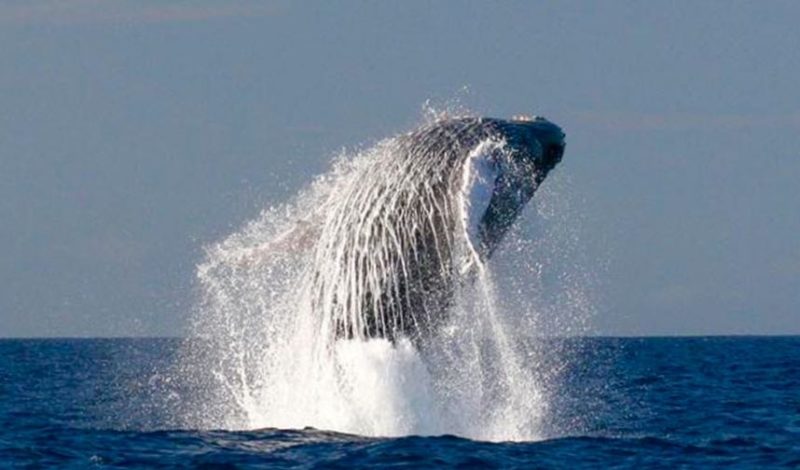
A Humpback Whale breaches off the coast of Oahu in Hawaii. Photo Credits: NOAA’s National Ocean Service on Flickr. See also the Hawaiian Islands Humpback Whale National Marine Sanctuary, the Office of National Marine Sanctuaries and NOAA’s National Ocean Service. (Original source: NOS Image Gallery
#3: How to hear the Humpback Whale song yourself
You have several options to see and hear the whales while they are in Hawaii. The most popular one, obviously, is visiting them up-close from a tour boat, but did you know that you also can hear the humpback whales sing yourself?
Only male humpback whales sing, and their songs are part of their competition for potential mates. Whales in the same area (which can be as large as an entire ocean basin) tend to sing similar songs, with only slight variations. Whales from non-overlapping regions sing entirely different songs. All whale songs are also constantly evolving, though at varying paces.
You can listen to a 13-minute recording of Hawaiian humpback whales singing by playing the audio fragment below. Don’t they sound a bit like cows?
As male humpback whales perform these songs most often during the mating season, you can think of them as a form of whale flirting or a courtship ritual.
Because sound carries further under water than on land, you can hear these songs even if they are performed several miles off shore. If you are swimming and are lucky enough to see whales out in the ocean, you need only to do the following:
Listen to the whales while swimming
- Swim out into the ocean, just past the point where the surf breaks. (careful, only do this when you are together with someone else, when the currents are low, and if you are a strong swimmer).
- Take a deep breath and swim to the bottom, dig your hands in the sand, or hold onto something under water like a rock (but be careful not to touch any corals).
- Clear your ears by closing your nose with your fingers and blowing air out of your nose. You should hear your ears “pop”.
- Listen and enjoy the whales serenades.
Listen to the whales while snorkeling
Snorkeling makes listening to the whale songs much easier, though of course, there still have to be whales within a couple of miles of your snorkeling spot. If this is the case (for example, if you see a telltale white water spout off shore), try the following:
- Find a spot that is more than 5 ft deep and away from the surf. You preferably want deeper water or a sandy ocean floor.
- Take a deep breath of air, dive down to the ocean floor and hold onto something. You will be deep enough when you can remain with your head a few feet under water without breaking the surface.
- Clear your ears by closing your nose with your fingers and blowing air out of your nose. You should hear your ears “pop”.
- Listen and enjoy!
#4: Where can you see the most whales in Hawaii?
Aerial surveys for whales, such as the one shown below, elegantly illustrate which places are best for whale spotting. Boat tours consistently visit these same waters for good reasons, and those wanting to catch a glimpse of the whales from shore would be wise to let this map guide their choice viewing spots as well.
For the Big Island you will have best chance of seeing whales in the North Kona, and north and south Kohala districts.
If you are very passionate about whale watching, but aren’t interested in a boat tour, you could consider spending the day in Waipi’o valley, hiking to Pololu valley, or having a sunset picnic in Holoholokai Beach Park.
Below are the results of an aerial survey for whales performed between 1993 and 2003. The red zones are the best spots for whale spotting. Scroll down for a better description of our 3 favorite on-shore whale watching spots.
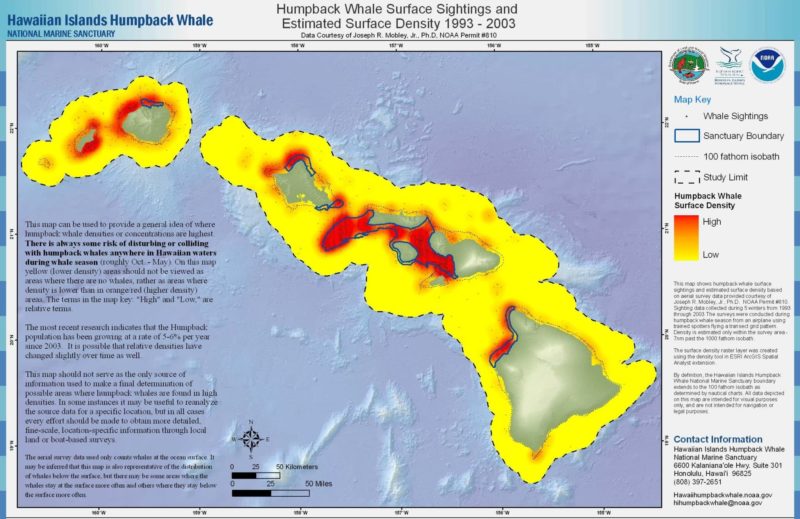
This map shows where you can best see whales on Hawaii. The red zones are the best spots to see whales, the yellow zones also have whale sightings but relatively less. Aerial survey data was collected by Dr. Joe Mobley from UH during 1993 – 2003 and the density surface was developed by the Hawaiian Islands Humpback Whale National Marine Sanctuary.
Why are humpback whales so amazing?
The immense (on average 45 ft, but lengths up to 60 ft are possible) humpback whales (na kohola) are an endangered species that was brought to the brink of extinction by whalers in the last century. Now, thanks to international protection, their numbers have increased to a current total global population of about 80 thousand. Of these, roughly 12 to 18 thousand (2015 estimate, see page 82, D.3.1 and D.4) visit Hawai’i during the winter months.
Just like us, whales are very playful and despite their size humpback whales are surprisingly acrobatic. They demonstrate this by frequently breaching (which you can see yourself) and slapping their tails on the water. Humpback whales are also renowned for their beautiful, haunting songs, which, again, you can experience yourself.
Humpback whales have a strong cultural value in Hawaii. To the native Hawaiians a whale is the representation of the Hawaiian god Kanaloa – the god of all ocean life.
The following trailer, filmed partly in Hawaiian waters, offers an up-close look at how humpback whales communicate, sing, feed, play and care for their young.
Why do the whales come to Hawaii
Humpback whales are a migratory species which means that they migrate every year between the cool waters close to the poles and (sub)tropical waters. Whales belonging to the North pacific whale population swim an average of 6,000 miles a year, but migrations of up to 16,000 miles a year have been documented! This makes Humpback Whales one of the best-traveled mammals in the world.
So why do the whales come to Hawai’i, you ask? Strangely enough, for the same reason as many of our other visitors: to take a break!
Humpback Whales spend their summers feeding and building up fat reserves in the cool higher latitude waters and then spend cold winters in our warmer tropical waters to mate, give birth, and to raise their calves (children) in a safe environment and far from natural predators.
Because there is very little food for the whales in (sub) tropical oceans they instead fast during their Hawaiian vacations and live off their fat reserves. The big advantage of the warm and food-poor waters is that there are not many large predators around that can prey on the young humpback whale calves. In essence, Hawaii offers them a bit of a safe zone.
That is why we can see whales in Hawaii:
